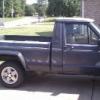Search the Community
Showing results for tags 'Closed system'.
-
I hesitate to even begin another post about a Comanche overheating. I've read all the posts I can find here and elsewhere. The problem is that its still overheating. I will give you a little background and what I have tried, then post a couple of questions. This is an 88MJ, 4.0L, SWB 2WD. mileage - around 400,000 miles. It has about 15k miles on a rebuilt motor, and a new radiator was put in at the same time. I have done a pressure check on all cylinders and they are all around 140-150. It ran OK all spring, then started overheating as the weather warmed up this past summer. (Note: I bought this truck new, and have NEVER had an overheating problem). Crank it, 5 minutes later its boiling over. My first purchase was an OEM reservoir and OEM cap, since it was blowing the old one off. After a few more boil-overs, I removed and replaced the thermostat. I bought the one with the little valve in it, and I put the valve near 12 o'clock. I went with what was recommended for the vehicle - 185 or 190 degrees. (In the past I've used a 165 degree) I realized that my problem was probably trapped air, so I changed the thermostat cover out with a newer model one that had an opening for a sensor in the top. I put a valve in there. (I saw this somewhere, it wasn't my concoction). I parked it nose up, jacked it up a little to get more angle, and bled it from the front. Same result. Five minutes, and it was in the red. I now know the right way to do this. As I was working with it, the water pump started to make a little noise, so I replaced the water pump and the fan clutch. Until this point, when it got hot, it would leak from somewhere. I had to reposition and super-tighten all hoses, and it still drips a few drops under pressure, but not like it did. I saw a post where someone mentioned the heater valve. That was a new revelation. There was no vacuum hooked up to it, so I held it open with a zip tie, turned the HVAC to warm, fan off, put it nose down, and burped it. ran it, let it cool. repeat. I've done that 4 times now. I remove the sensor, air comes out, coolant comes out. reinstall sensor, run it, and now it takes about 7 minutes to get to about 235+, and here's the kicker. When cool, the reservoir is almost full. When I bleed the air out, the reservoir goes down to about 1 inch of fluid. After I run the cycle and let it cool, its at the same place it was before. There is no less air in the system after 4 times burping it. I havent had to add coolant. That confuses me, cause that means the air I burp out comes right back - do I just need to keep on doing this? So, here are my main questions: 1) Could the higher temp thermostat be the problem? or, rather, could a lower temp thermo help? 2) I plan on bypassing the heater valve, but until then, could that be the source of my problem? 3) When running it to burp it should the heat actually be blowing, or just in the warm position, fan off? 4) I looked at the metal reservoir method, the closed to open system change (with and without radiator replacement). I have the Moroso inline filler on order for the top radiator hose, but haven't figured out which reservoir would be best. Has anyone found one that fits well where the reservoir sits? Any tips? 5) My question here is how the heck does the open system work better? How does any fluid in the overflow get pulled back in the system if needed? I'd really like to be able to wrap my head around this. 6) What have I missed, or where did I go wrong? This almost has to be something "easy" that my ADD just skipped right over. Thanks in advance, guys.
- 23 replies
-
- Cooling system
- open system
-
(and 3 more)
Tagged with:
-
87 Renix 4.0, closed system. My engine was rebuilt last year and has only a few thousand mile so far. I believe all small parts were replaced. On Friday, I loaded up the MJ for a weekend camp trip. Nothing heavy, just tent, sleeping bags, cooler, etc. and a passenger. This is probably the most weight it has carried since the rebuild. The outside temp was mild - 70s. I started out and looked down at the cluster. The temp gauge usually stops at the first line. Very seldom does it rise above this. Well, I was watching it continue past that and go above 210. I had only driven 3 miles. Then the temp dropped down to "normal," just above the first line. I stopped at a McD's for coffee. I looked under the hood and noticed antifreeze around the reservoir bottle. The cap was loose and would no longer screw down tight. i turned back and tranferred all my gear into a Suburban. I have ordered a new cap from NAPA. For the big question: Should I replace the T-stat also? What may have caused the sudden, rapid rise, and rapid drop?
- 16 replies
-
- Reservoir Cap
- T-stat
-
(and 1 more)
Tagged with:


